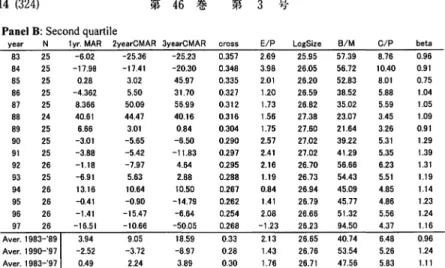Cross‑shareholding and the Long‑run
Performance of Stock Returns in the Japanese Keiretsu : An Empirical Analysis using panel data
著者 Jurgen Schraepen
journal or
publication title
關西大學商學論集
volume 46
number 3
page range 301‑331
year 2001‑08‑25
URL http://hdl.handle.net/10112/00018988
関西大学商学論集 第4
6巻第
3号
(2001年
8月 )
(301) 91Cross‑shareholding and the Long‑run Performance of Stock Returns in the Japanese Keiretsu : An
Empirical Analysis using panel data Jurgen Schraepen
Abstract
Using a sample of Japanese keiretsu firms, this paper examines the relation between the cross‑holding of equity and the long‑run perfor‑ mance of stock returns. We set the hypothesis that under the paradigm and neoclassical theory of profit maximization, the objective of cross‑ shareholding must be to maximize the stock‑returns of the firm, so that there should exist an abnormal return premium for investing in a portfolio of firms with a high percentage of cross‑shareholding. Making portfolio's conditional on the percentage of cross‑shareholding and calculating their cumulative market‑adjusted returns, we find that comparing with the market return, the high cross‑shareholding portfolio did not significantly outperform or underperform the market return in the 15 year period of our sample. Comparing the returns of the high and low cross‑shareholding portfolio's, we find that the high cross‑ shareholding Portfolio only ou
ゆ
erformed the low cross‑shareholding portfolio in the 1990‑'97 period. For the 1983‑'89 period we find arelative strong underperformance. From the evidence of the pooled and fixed effect panel data regressions, we find evidence that a higher level of cross‑shareholding is related to lower stock returns in the 1983‑'89 Period. For the 1990‑'97 period, there
i s
evidence of a Positive impact92 (302)
第
46巻 第
3号
but these results are not robust. Taking all the evidence together, we can conclude that a higher level of cross‑shareholding does not lead to higher stock returns. Firms who hold a high percentage of equity in other
ガ
rmsin the keiretsu do this not necessaガlyto maximize their market value of equity or stock returns. This conclusion is similar to that of Nakatani (1984) who found that the puゅ
oseof belonging to the keiretsu is not to maximize the profits of theガ
rm.Cross‑shareholding and the Long‑run Performance of Stock Returns in the Japanese Keiretsu: An Empirical Analysis using panel data (Jurgen) (303) 93
I • Introduction
A remarkable feature of the Japanese capital market is unmistakenly the cross‑holding of equity ('Kabushiki mochiai'in Japanese) between firms. Being something almost only existing in Japan, cross‑sharehold‑ ing has had great impact on the Japanese corporate structure. Cross‑ shareholding as a form of ownership of the firm, together with other features of the Japanese financial market, has created the base for manager's control of the firm, has made possible the longterm and stable relationship between companies and is one of the basic structures of what we now know as Japanese management.
The cross‑holding of equity is most prominent in the keiretsu, the six major company groups that include some of the biggest companies in Japan1>. In a company group an average of up to 20
%
of all shares are being held inside the same group (see appendix 1), and it is the main bank that takes the central position in the shareholding of equity and that plays a major role in the financial activities and governing of the keiretsu.The Japanese keiretsu and its main feature of reciprocal sharehold‑ ings among its member firms has been described extensively in the literature (Aoki, 1988; Sheard, 1986, 1989, 1994; Lincoln, Gerlach, Takahashi, 1992; Flath, 1996; Bergl5f and Perotti, 1994). Aggregated, the cross‑shareholding of equity, where each company in the keiretsu holds, and is being hold a small percentage in the equity of other firms,
1)
There are 6 financial keiretsu, who can be divided in keiretsu that originated from the pre‑war Zaibatsu (Mitsubishi, Mitsui and Sumitomo) and the keiretsu that developed around banks (Sanwa, Dai‑ichi Kangyo(DKB) and Fuji).94 (304) 第
4 6
巻 第3 号
can assure mutual control between the firms. It is often said the keiretsu and its reciprocal shareholdings are merely something sym‑
bolic, but in the literature they are seen as a part of the governance mechanism. The functions of cross‑shareholding are said to be facilitat‑ ing trade between their member firms (Caves and Uekusa, 1976); to exchange information (Goto, 1982); enforcing reorganizations of firms in financial distress (Sheard, 1986); to defend oneself against takeovers (Aoki, 1987; Ramseyer, 1987; Sheard, 1991); or to enhance risk‑sharing among member firms (Sheard, 1989,1994; Nakatani, 1984).
Many empirical studies have also looked into the ownership concen‑ tration in the keiretsu and firm performance in Japan. One study is that of Caves and Uekusa (1976). They tested the hypothesis of joint‑profit maximization of the keiretsu, and examined whether the group‑affiliat‑ ed firms earned higher profits than other, independent companies. They found that profits on total assets for the 1961‑70 period are negatively related to group affiliation.
Another more influential empirical study on the equity ownership structure in the keiretsu and firm performance is that of N akatani (1984). Under the paradigm of neoclassical theory where the firm maximizes its profits or market value, N akatani, just like Caves and Uekusa, tests the hypothesis whether the keiretsu or corporate group‑ ings enhance profitability. His empirical analysis shows that the aver‑ age profitability and the growth rate of profits is significantly lower in keiretsu or group affiliated firms than in independent firms. N akatani' s empirical findings for his sample period of 1971‑82 hereby confirm the results of the Caves and Uekusa study that firms affiliated with groups or keiretsu are not profit maximizers. However, Nakatani finds clear evidence that the variability of performance of the group‑affiliated

